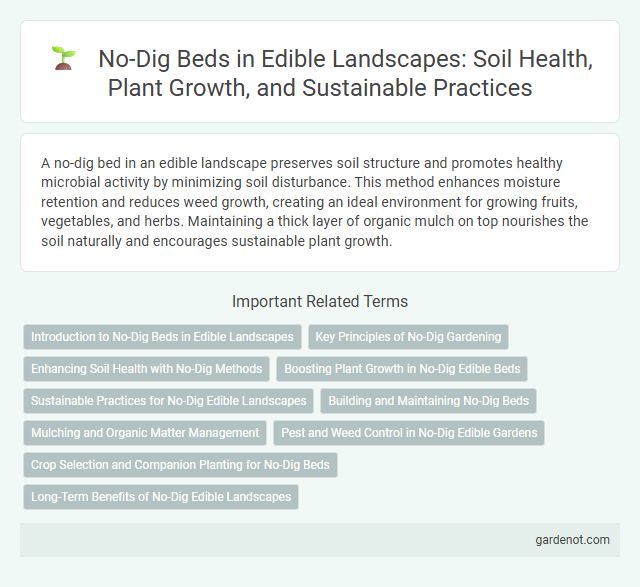A no-dig bed in an edible landscape preserves soil structure and promotes healthy microbial activity by minimizing soil disturbance. This method enhances moisture retention and reduces weed growth, creating an ideal environment for growing fruits, vegetables, and herbs. Maintaining a thick layer of organic mulch on top nourishes the soil naturally and encourages sustainable plant growth.
Introduction to No-Dig Beds in Edible Landscapes
No-dig beds revolutionize edible landscapes by minimizing soil disturbance, preserving beneficial microorganisms and earthworm populations essential for plant health. This method involves layering organic materials such as compost, mulch, and cardboard directly on the soil surface, promoting nutrient-rich, loose soil ideal for root growth and moisture retention. No-dig beds enhance sustainability and productivity by reducing weed competition and soil erosion while fostering robust edible plant ecosystems.
Key Principles of No-Dig Gardening
No-dig gardening emphasizes maintaining soil structure by avoiding tilling, preserving beneficial microorganisms and earthworm activity. Mulching with organic materials like compost, straw, or leaves enhances moisture retention and suppresses weeds while enriching the soil naturally. This method promotes healthier plant roots and increases soil fertility through layered organic matter decomposition.
Enhancing Soil Health with No-Dig Methods
No-dig beds enhance soil health by preserving its natural structure and microbial ecosystems, promoting nutrient cycling and moisture retention. Avoiding tillage reduces soil erosion and compaction, fostering a thriving environment for beneficial earthworms and microorganisms. This method supports long-term fertility and robust plant growth in edible landscapes.
Boosting Plant Growth in No-Dig Edible Beds
No-dig beds enhance plant growth by preserving soil structure and microbial life essential for nutrient absorption. Organic matter decomposes naturally on the surface, releasing nutrients steadily without disrupting root systems. This method improves moisture retention and aeration, fostering robust edible plants and higher yields.
Sustainable Practices for No-Dig Edible Landscapes
No-dig beds promote sustainable practices by preserving soil structure and enhancing microbial activity, which increases nutrient availability and reduces erosion. Organic mulch layers suppress weeds, retain moisture, and contribute to soil fertility as they decompose, minimizing the need for chemical inputs. Integrating crop diversity and compost into no-dig systems fosters resilient ecosystems that support long-term productivity within edible landscapes.
Building and Maintaining No-Dig Beds
Creating no-dig beds involves layering organic materials such as compost, mulch, and cardboard directly on the soil surface, which enriches soil fertility while suppressing weeds and minimizing disturbance to soil structure. Maintaining no-dig beds requires regular addition of organic matter like kitchen scraps and leaf mold, promoting beneficial microbial activity and enhancing soil health over time. This method supports sustainable edible landscapes by improving moisture retention and fostering robust root systems for vegetables, herbs, and fruit plants.
Mulching and Organic Matter Management
Mulching plays a crucial role in no-dig bed systems by suppressing weeds, conserving soil moisture, and regulating temperature, which enhances plant health and yield. Organic matter management through the application of compost, leaf mold, and other natural materials enriches soil fertility, promotes beneficial microbial activity, and improves soil structure without disturbing soil layers. This approach supports sustainable edible landscapes by maintaining soil integrity and reducing the need for synthetic inputs.
Pest and Weed Control in No-Dig Edible Gardens
No-dig beds in edible landscapes enhance pest and weed control by preserving soil structure and fostering beneficial microbial activity that naturally suppresses pests. Mulching with organic materials like straw or compost creates a barrier to weed germination and maintains moisture, reducing the need for chemical interventions. This method supports healthy plant growth while minimizing disturbances that often promote weed spreading and pest infestations.
Crop Selection and Companion Planting for No-Dig Beds
No-dig beds thrive with crop selection that prioritizes deep-rooted vegetables like carrots, parsnips, and beets, which minimize soil disturbance and enhance nutrient uptake. Companion planting in no-dig systems encourages beneficial relationships, such as planting nitrogen-fixing legumes alongside heavy feeders like corn or brassicas to naturally enrich the soil. Integrating herbs like basil and marigolds can deter pests while supporting pollinators, creating a balanced micro-ecosystem that maximizes yield and soil health in edible landscapes.
Long-Term Benefits of No-Dig Edible Landscapes
No-dig edible landscapes promote soil health by preserving microbial ecosystems and improving organic matter content, which enhances nutrient availability over time. This method reduces soil erosion and compaction, fostering better water retention and root development for sustainable crop production. Long-term adoption of no-dig beds increases biodiversity and lowers labor and resource inputs, making edible landscapes more resilient and productive.
No-dig bed Infographic

 gardenot.com
gardenot.com